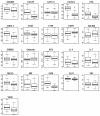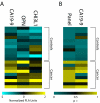Identification of a biomarker panel using a multiplex proximity ligation assay improves accuracy of pancreatic cancer diagnosis
- PMID: 20003342
- PMCID: PMC2796647
- DOI: 10.1186/1479-5876-7-105
Identification of a biomarker panel using a multiplex proximity ligation assay improves accuracy of pancreatic cancer diagnosis
Abstract
Background: Pancreatic cancer continues to prove difficult to clinically diagnose. Multiple simultaneous measurements of plasma biomarkers can increase sensitivity and selectivity of diagnosis. Proximity ligation assay (PLA) is a highly sensitive technique for multiplex detection of biomarkers in plasma with little or no interfering background signal.
Methods: We examined the plasma levels of 21 biomarkers in a clinically defined cohort of 52 locally advanced (Stage II/III) pancreatic ductal adenocarcinoma cases and 43 age-matched controls using a multiplex proximity ligation assay. The optimal biomarker panel for diagnosis was computed using a combination of the PAM algorithm and logistic regression modeling. Biomarkers that were significantly prognostic for survival in combination were determined using univariate and multivariate Cox survival models.
Results: Three markers, CA19-9, OPN and CHI3L1, measured in multiplex were found to have superior sensitivity for pancreatic cancer vs. CA19-9 alone (93% vs. 80%). In addition, we identified two markers, CEA and CA125, that when measured simultaneously have prognostic significance for survival for this clinical stage of pancreatic cancer (p < 0.003).
Conclusions: A multiplex panel assaying CA19-9, OPN and CHI3L1 in plasma improves accuracy of pancreatic cancer diagnosis. A panel assaying CEA and CA125 in plasma can predict survival for this clinical cohort of pancreatic cancer patients.
Figures



Similar articles
-
Growth differentiation factor (GDF-15) concentration combined with Ca125 levels in serum is superior to commonly used cancer biomarkers in differentiation of pancreatic mass.Cancer Biomark. 2018 Feb 14;21(3):505-511. doi: 10.3233/CBM-170203. Cancer Biomark. 2018. PMID: 29171983
-
Applicative Value of Serum CA19-9, CEA, CA125 and CA242 in Diagnosis and Prognosis for Patients with Pancreatic Cancer Treated by Concurrent Chemoradiotherapy.Asian Pac J Cancer Prev. 2015;16(15):6569-73. doi: 10.7314/apjcp.2015.16.15.6569. Asian Pac J Cancer Prev. 2015. PMID: 26434876
-
Identification of Serum Biomarker Panels for the Early Detection of Pancreatic Cancer.Cancer Epidemiol Biomarkers Prev. 2019 Jan;28(1):174-182. doi: 10.1158/1055-9965.EPI-18-0483. Epub 2018 Oct 17. Cancer Epidemiol Biomarkers Prev. 2019. PMID: 30333219 Free PMC article.
-
Roles of CA19-9 in pancreatic cancer: Biomarker, predictor and promoter.Biochim Biophys Acta Rev Cancer. 2021 Apr;1875(2):188409. doi: 10.1016/j.bbcan.2020.188409. Epub 2020 Aug 19. Biochim Biophys Acta Rev Cancer. 2021. PMID: 32827580 Review.
-
Strategies for discovering novel pancreatic cancer biomarkers.J Proteomics. 2013 Apr 9;81:126-34. doi: 10.1016/j.jprot.2012.09.025. Epub 2012 Sep 28. J Proteomics. 2013. PMID: 23026552 Free PMC article. Review.
Cited by
-
Single-Cell Analysis of Multiple Steps of Dynamic NF-κB Regulation in Interleukin-1α-Triggered Tumor Cells Using Proximity Ligation Assays.Cancers (Basel). 2019 Aug 16;11(8):1199. doi: 10.3390/cancers11081199. Cancers (Basel). 2019. PMID: 31426445 Free PMC article.
-
Differential gene expression analysis of peripheral blood mononuclear cells reveals novel test for early detection of pancreatic cancer.Cancer Biomark. 2011-2012;11(1):1-14. doi: 10.3233/CBM-2012-0260. Cancer Biomark. 2011. PMID: 22820136 Free PMC article.
-
Novel Diagnostic and Predictive Biomarkers in Pancreatic Adenocarcinoma.Int J Mol Sci. 2017 Mar 20;18(3):667. doi: 10.3390/ijms18030667. Int J Mol Sci. 2017. PMID: 28335509 Free PMC article. Review.
-
Assay methods based on proximity-enhanced reactions for detecting non-nucleic acid molecules.Front Bioeng Biotechnol. 2023 Jun 29;11:1188313. doi: 10.3389/fbioe.2023.1188313. eCollection 2023. Front Bioeng Biotechnol. 2023. PMID: 37456730 Free PMC article. Review.
-
Toward development of a surface-enhanced Raman scattering (SERS)-based cancer diagnostic immunoassay panel.Analyst. 2013 Jan 21;138(2):410-6. doi: 10.1039/c2an36128k. Analyst. 2013. PMID: 23150876 Free PMC article.
References
-
- Ries LAG, Melbert D, Krapcho M, Stinchcomb DG, Howlader N, Horner MJ, Mariotto A, Miller BA, Feuer EJ, Altekruse SF, Lewis DR, Clegg L, Eisner MP, Reichman M, Edwards BK, (Eds) SEER Cancer Statistics Review, 1975-2005. Bethesda, MD: National Cancer Institute; 2008.
-
- Frebourg T, Bercoff E, Manchon N, Senant J, Basuyau JP, Breton P, Janvresse A, Brunelle P, Bourreille J. The evaluation of CA 19-9 antigen level in the early detection of pancreatic cancer. A prospective study of 866 patients. Cancer. 1988;62:2287–2290. doi: 10.1002/1097-0142(19881201)62:11<2287::AID-CNCR2820621103>3.0.CO;2-H. - DOI - PubMed
-
- Magnani JL, Steplewski Z, Koprowski H, Ginsburg V. Identification of the gastrointestinal and pancreatic cancer-associated antigen detected by monoclonal antibody 19-9 in the sera of patients as a mucin. Cancer Res. 1983;43:5489–5492. - PubMed
Publication types
MeSH terms
Substances
Grants and funding
LinkOut - more resources
Full Text Sources
Other Literature Sources
Medical
Research Materials
Miscellaneous

